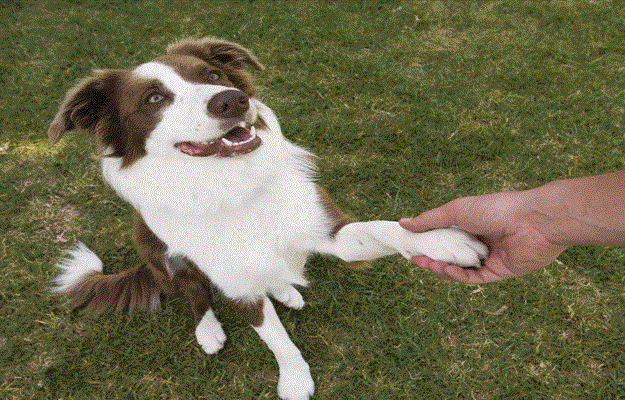
Shake is what I consider a “trick staple.” It’s cute, clever, and fun for any dog to learn. It’s also sure to impress your visitors. Guests will much prefer shaking your dog’s paw in greeting rather than being jumped on
What it Looks Like
Your dog will offer his paw for you to hold and gently shake.
Before you Begin
Fido’s very favorite treats are a must. I recommend soft and stinky edibles as you’ll be able to work at a faster pace if Fido is not stopping to crunch big biscuits.
6 Steps to a Professional Shake
#1 Find a Quiet Place
As always, the key to “Trick Triumph” is to work in a non-distracting environment. Take Fido into the quietest room of your home whenever you begin teaching him a new behavior. Few of us would succeed in learning a new skill if our family members were “chatting it up” in the same room.
#2 Envision a Plan
Envision what you want Fido to do: he must raise his paw so that you can hold it, but you do not just want to grab his paw and start shaking it for him. Fido probably won’t appreciate you treating his paw like a Polaroid picture! You’re not doing his brain any favors by performing the trick on your own; you want Fido to figure out how to shake with you. What your dog figures out on his own, he’ll remember!
#3 Tickle a Paw
Sit on the ground in front of Fido and place a few treats in one hand. With your other empty hand, reach down and softly tickle the bottom of his paw (either paw will do, I usually trickle the paw which is the mirror image to myself – I tickle Fido’s left paw with my right fingers). The light tickling should cause Fido to move his paw upward and when he does cheer “Yes!” and pop a tasty treat into his mouth. Even if he only moves his paw a centimeter, you must reward him.
#4 Do it Again
Repeat Step 3 until Fido is consistently raising his paw upon feeling the “tickle”. Fido should start to figure out this game: he gets treats for lifting his paw. The next time you reach toward his paw, do not tickle it — just wait. Fido should move his paw all on his own. When he does, praise him immensely and spoil him with treats. Great! Now Fido understands to lift his paw as you reach toward him.
#5 Make it Last
It’s now time for Fido to learn how to place his paw into your hand so that our professional shake can occur. As Fido raises his paw, you will simply place your hand a few inches under his. As his paw moves downward and touches your hand, say an enthusiastic “Yes!” and reward him. Repeat Step 5 until Fido is successfully lifting his paw and contacting your hand. Increase the duration that Fido’s paw is in your hand by delaying your “Yes!” and his reward by two or three seconds. Fido should be contacting your hand now and waiting to hear your verbal praise before moving his paw away.
#6 Put it All Together
Now that Fido is placing his paw into your hand, you need to add in the shaking motion. Start by moving your hand just a little and rewarding Fido lavishly for not pulling his paw away. If he does pull his paw away simply take a step back and move your hand a little less. Build up Fido’s confidence by gradually making the “handshake” longer.
Congratulations! Your dog is shaking your hand! You may now name the trick and begin saying: “Shake” as you reach out your hand. keep practicing and you can teach Fido to shake both with his left and right paws.
Pooch Pointers
Realize that some dog breeds (the Boxer, for example) are naturally more inclined to offer their paw than others. If you have a dog that is sensitive about having his feet handled (perhaps he’s paranoid about an upcoming pedicure) then you must be very patient. You may need to start by simply building up a positive association with your dog’s paw being touched at all. Start by simply grazing your dog’s foot with your fingers and immediately pop treats into his mouth. Your criteria are low at this point: Reward Fido generously for just holding still and not recoiling his foot. If your dog learns that 90 percent of the time, you simply touch his paws and he gets treats (verses nail trimmings), he will start to relax (and nail trimmings won’t seem too awful either!). It would be like Dr. Smile giving you a crispy one hundred dollar bill every time you remembered to “open wide” at the dentist’s office. Remember to keep your training sessions short, end on a success and have fun!
Tara Baggerman is the trainer & owner of Caliber Canines Positive Dog Training.
Related Articles & Free Email Newsletter Sign Up
How But More Importantly Why You Should Teach Your Dog to Spin
How to Teach Your Dog to Crawl in 6 Easy Steps




Comment here